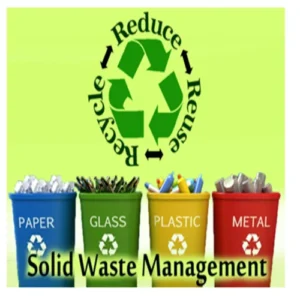
Why in news?
- India’s economic boom and burgeoning population have brought undeniable progress, but also a pressing challenge – solid waste management.
- The recent Supreme Court’s critique of New Delhi’s situation, with over 3,800 tonnes of untreated waste posing health and environmental threats, underscores the national urgency.
Understanding Solid Waste Management
- Solid waste encompasses various categories, including household waste, commercial waste, construction and demolition debris, and agricultural residue.
- India, with roughly 18% of the global population, generates a staggering 12% of the world’s municipal solid waste – a figure estimated to reach 165 million tonnes by 2030 due to changing consumption patterns.
The Rotting Issues:
- India’s solid waste management battles multiple challenges:
- Poor Implementation of Rules: Despite the well-intentioned Solid Waste Management Rules, 2016, which emphasize waste segregation at source and producer responsibility, implementation remains a hurdle. Overflowing and damaged bins, coupled with a lack of source segregation, lead to unprocessed mixed waste reaching landfills. Furthermore, some areas lack regular collection services, creating unsanitary conditions.
- Landfill Blues: Land scarcity in metro cities hinders the establishment of adequate waste processing plants. This, along with illegal dumping and poor coordination among stakeholders, exacerbates the problem. Even existing facilities struggle to manage the influx, leading to environmental hazards like methane emissions, leachate contamination, and landfill fires. Biomining efforts, initiated in 2019 to tackle legacy waste, are projected for completion by 2026, offering a temporary reprieve. However, without addressing the root cause of improper waste management, landfills will continue to grow.
- Data Deficiencies: The lack of comprehensive data on waste generation across different regions makes it difficult for private companies to assess the potential of waste management projects. This data gap hinders informed decision-making and investment in effective solutions.
- Formal vs. Informal Divide: Municipal collection services often fall short in low-income communities, creating a gap filled by the informal waste picking sector. These informal waste pickers, often lacking proper safety gear and working in unhygienic conditions, face significant health risks. Child labor within this sector remains a concern.
- Public Awareness Gap: A general lack of public awareness and proper waste management practices contributes to the problem. Littering and improper disposal habits add to the already overflowing waste bins.
Legislative Framework:
- The Solid Waste Management Rules, 2016, aimed to address these issues by mandating:
- Waste segregation at source into three streams: wet (biodegradable), dry (recyclables), and hazardous waste.
- Producer responsibility for the disposal of packaging and sanitary waste.
- User fees for collection, disposal, and processing from bulk generators.
Complementary Initiatives:
- Plastic Waste Management Rules, 2016:
- This regulation focuses on minimizing plastic waste generation, preventing littering, and ensuring segregated storage of plastic waste.
- Bio-Medical Waste Management Rules, 2016:
- These rules aim at proper management of bio-medical waste generated by healthcare facilities.
- Waste to Wealth Portal:
- This online platform identifies and promotes technologies for converting waste into energy, recyclable materials, and valuable resources.
- Project REPLAN:
- This initiative aims to utilize processed and treated plastic waste blended with cotton to create carry bags.
The Road Ahead:
- Strengthening Municipal Capacity:
- Cities need to enhance waste processing capacities in anticipation of population growth. This includes a focus on composting and biogas generation for biodegradable waste, alongside establishing and operating facilities through stakeholder consultations.
- Waste-to-Energy Justification:
- Refuse-derived fuel (RDF), composed of non-recyclable dry waste, offers a high calorific value and can be used for power generation in waste-to-energy projects.
- Decentralized Processing:
- Implementing decentralized waste processing in metropolitan areas, potentially through collaboration with neighboring states, can expedite waste management.
- Establishing composting facilities in nearby areas can leverage existing organic compost markets. Micro-composting centers and dry waste collection centers, inspired by successful models in other Indian states, can be replicated for efficient local waste management.
- Integrated Approach:
- Combining decentralized options with large-scale processing facilities presents a comprehensive solution to ensure all waste receives proper treatment.
Conclusion
- India’s solid waste management challenges demand immediate and multi-pronged solutions.
- Stricter enforcement of existing regulations, coupled with investment in infrastructure, public awareness campaigns, and fostering innovation in waste management technologies, are crucial steps towards a cleaner and healthier future for India.
- By adopting a holistic approach that prioritizes waste segregation, processing, and responsible disposal, India can turn this growing heap.
People also ask
Q1: What is solid waste?
Ans: Solid waste encompasses various types of trash, including household waste, commercial waste, construction and demolition debris, and agricultural residue.
Q2: How big is India’s solid waste problem?
Ans: India generates a significant portion of the world’s municipal solid waste – roughly 12% globally – and this figure is expected to rise due to population growth and changing consumption patterns.
Q3: What are the main challenges in solid waste management in India?
Ans: India’s solid waste woes stem from a complex web of issues: unsegregated waste overflowing landfills due to lax enforcement, limited space for processing plants in cities, lack of data for informed solutions, a gap between formal collection and the informal sector with its worker safety issues, and a general lack of public awareness about proper waste management.
Q4: What are the key regulations governing solid waste management in India?
Ans: The Solid Waste Management Rules, 2016 mandate waste segregation at source, producer responsibility for specific waste types, and user fees for collection and processing.
Your article helped me a lot, is there any more related content? Thanks!